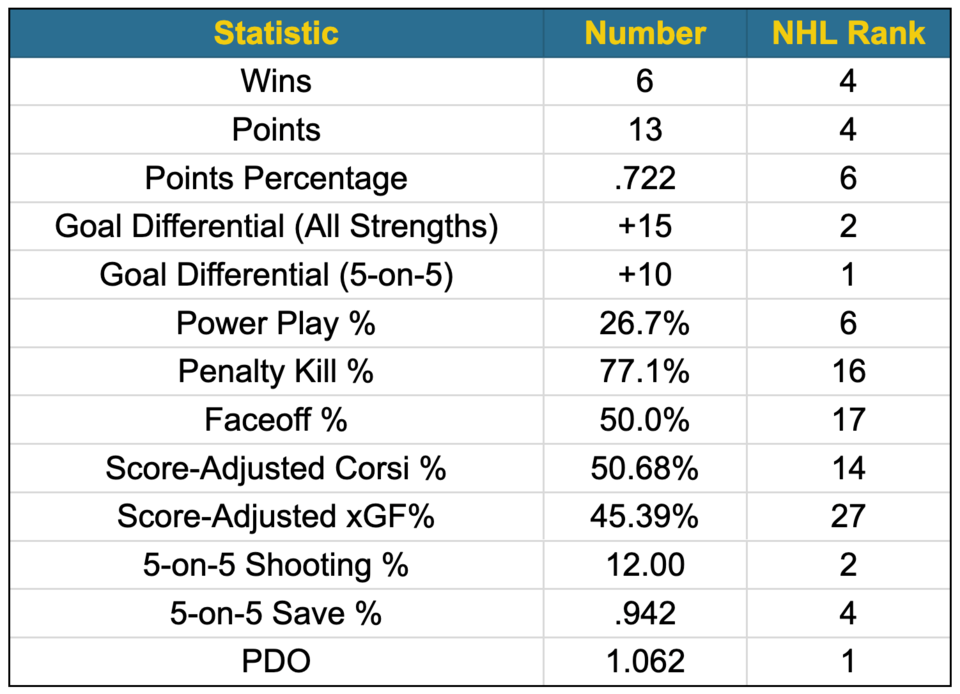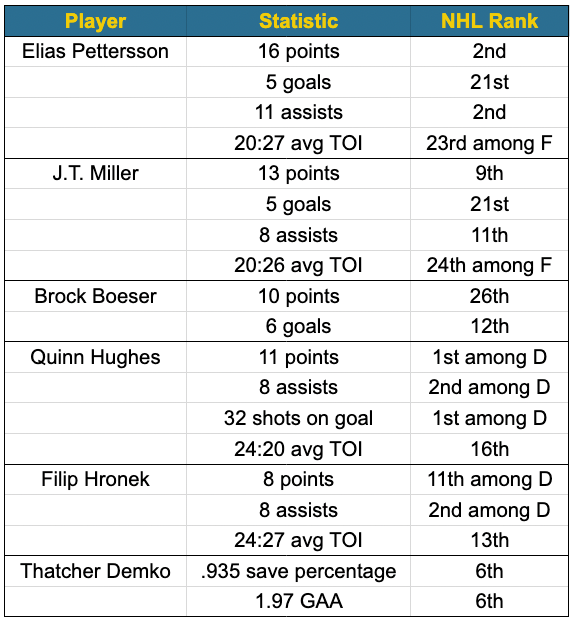The Vancouver Canucks repeatedly emphasized the importance of a strong start this season and that emphasis definitely paid off in October. They won a very nice six of their nine games and proved that they could win in multiple ways, whether it’s blowing the roof off an opponent, grinding away to a one-goal victory, or finding a way to win when being outplayed.
It’s a nice switch from their last two Octobers, where the Canucks went 3-5-1 and 2-5-2, digging themselves an early hole. This October, they did the opposite of digging a hole, which I guess is building a pile.
In any case, things have been going very well for the Canucks, so let’s take a moment to take stock of October before heading off into the rest of the season. To do so, we’ll use everyone’s favourite arithmetical value used to represent quantity: numbers!
The Canucks are a top-five team in the NHL
Let’s start with the team numbers. They are almost universally very, very good.

All of these statistics come via either NHL.com or Natural Stat Trick.
The Canucks are top five in wins, top five in points, top two in overall goal differential, and first-overall in 5-on-5 goal differential. They also barely miss the top five in points percentage — they’ve played more games than some of the teams behind them in points — and on the power play, as there have been some truly bonkers power plays around the NHL to start the season.
All of this is incredibly impressive for a team that the majority of pundits picked to miss the playoffs and even the most optimistic analytic models had them at essentially a coin flip for a postseason berth.
Some of their other numbers aren’t quite as shiny, but are still fine.
Their penalty kill percentage is right at the NHL average, which is a vast improvement from last season, and it arguably undersells how much it has actually improved via the eye test and includes a couple of 5-on-3 goals that skew things a little.
Their score-adjusted corsi percentage is also above 50%, which indicates that they’re generally out-attempting their opponents at 5-on-5 when you account for score effects. That indicates they’ve essentially been a league-average puck possession team at 5-on-5, which isn’t a bad place to be for a team with top-tier goaltending, a handful of elite finishers, and a strong power play.
There are a couple of red flags, however. While their corsi has been strong, their expected goals percentage has been near the bottom of the league.
That’s less than ideal and indicates the Canucks advantage in shot attempts has not translated to an advantage in scoring chances. According to Natural Stat Trick, the Canucks have given up 91 high-danger chances this season at 5-on-5 and have only had 67 themselves.
That’s a number that might even out over time, so there might not be cause for concern just yet, but it’s something to keep an eye on.
Those scoring chance and expected goals numbers haven’t mattered much, of course, because the Canucks have been shooting the lights out and getting exceptional goaltending, giving them a league-leading PDO. Sure, it might regress in the future, but it made for a fantastic October.
Elias Pettersson, Quinn Hughes, and Thatcher Demko are elite
Let’s look at some individual numbers that stand out, starting with the boxscore numbers like points and time on ice. Several Canucks rank in the top 30, top 10, or even top one in various categories.

Elias Pettersson is utterly dominating, moving up to second in the NHL in scoring after his hat trick on Tuesday night. He’s also second in the NHL in assists.
That means Pettersson is on pace for a cool 146 points this season, which would absolutely shatter Henrik Sedin’s franchise record of 112 points. He’s probably not going to do that but at this point, who knows? You could even argue that Pettersson hasn’t even played at his top gear yet this season and that he has more to give.
Not far behind Pettersson is J.T. Miller, with 13 points putting him in the top ten in NHL scoring and on pace to crack the 100 point barrier that he came one point shy of in the 2021-22 season. Both Pettersson and Miller are in the top 30 among NHL forwards in average time on ice as well.
Brock Boeser’s initial goalscoring burst in the first game of the season has him 12th in the NHL in goals and he’s also in the top 30 in points. He’s on pace for 55 goals this season but I think fans — and Boeser himself — would be happy to see him finally reach the 30-goal mark this season.
Then there’s the top pairing on defence. Quinn Hughes is first among NHL defencemen in scoring, jumping to the top of the list after his three assists on Tuesday. He’s on pace for 100 points this season, which would be only the second 100-point season by an NHL defenceman since 1992.
Hughes is also second among defencemen in assists and surprisingly leads all defencemen in shots on goal, making good on his promise to shoot more this season.
Meanwhile, Filip Hronek has benefited from feeding the puck to Hughes, as his 8 points — all assists — have him 11th among defencemen in scoring and tied with Hughes for second among defencemen in assists.
Hronek is ahead of Hughes in one category: ice time. He’s averaged 24:27 per game, seven seconds ahead of Hughes, which has him 13th in the NHL.
Finally, we have Thatcher Demko. Among the 51 NHL goaltenders with at least four starts this season, Demko's .935 save percentage ranks sixth, as does his 1.92 goals against average.
If Demko maintained a .935 save percentage for the whole season, that would be the best of his career by 20 points. He has been very, very good, with Natural Stat Trick estimating he has saved 4.90 goals above average given the quality of shots he has faced, which ranks fifth in the NHL.
There’s no denying, it was quite the October for the Canucks. Can they keep it rolling in November?




